陕西科技大学:《包装技术基础 Fundamentals of Packaging Technology》课程PPT教学课件(英文版)Lesson 16 Distribution Packaging 第16课 运输包装

Lesson 16 Distribution Packaging 第16课 运输包装
Lesson 16 Distribution Packaging 第16课 运输包装
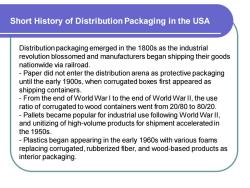
Short History of Distribution Packaging in the USA Distribution packaging emerged in the 1800s as the industrial revolution blossomed and manufacturers began shipping their goods nationwide via railroad. - Paper did not enter the distribution arena as protective packaging until the early 1900s, when corrugated boxes first appeared as shipping containers. - From the end of World War I to the end of World War II, the use ratio of corrugated to wood containers went from 20/80 to 80/20. - Pallets became popular for industrial use following World War II, and unitizing of high-volume products for shipment accelerated in the 1950s. - Plastics began appearing in the early 1960s with various foams replacing corrugated, rubberized fiber, and wood-based products as interior packaging
Short History of Distribution Packaging in the USA Distribution packaging emerged in the 1800s as the industrial revolution blossomed and manufacturers began shipping their goods nationwide via railroad. - Paper did not enter the distribution arena as protective packaging until the early 1900s, when corrugated boxes first appeared as shipping containers. - From the end of World War I to the end of World War II, the use ratio of corrugated to wood containers went from 20/80 to 80/20. - Pallets became popular for industrial use following World War II, and unitizing of high-volume products for shipment accelerated in the 1950s. - Plastics began appearing in the early 1960s with various foams replacing corrugated, rubberized fiber, and wood-based products as interior packaging

Functions and Goals of Distribution Packaging The functions of distribution packaging can be summarized as follows: Containment Protection Performance Communication - Most distribution packaging should address the following goals: Product protection: Ease of handling and storage Shipping effectiveness Manufacturing efficiency: Ease of identification Customer needs Environmental responsibility
Functions and Goals of Distribution Packaging The functions of distribution packaging can be summarized as follows: Containment Protection Performance Communication - Most distribution packaging should address the following goals: Product protection: Ease of handling and storage Shipping effectiveness Manufacturing efficiency: Ease of identification Customer needs Environmental responsibility
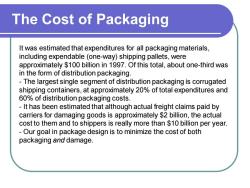
The Cost of Packaging It was estimated that expenditures for all packaging materials, including expendable (one-way) shipping pallets, were approximately $100 billion in 1997. Of this total, about one-third was in the form of distribution packaging. - The largest single segment of distribution packaging is corrugated shipping containers, at approximately 20% of total expenditures and 60% of distribution packaging costs. - It has been estimated that although actual freight claims paid by carriers for damaging goods is approximately $2 billion, the actual cost to them and to shippers is really more than $10 billion per year. - Our goal in package design is to minimize the cost of both packaging and damage
The Cost of Packaging It was estimated that expenditures for all packaging materials, including expendable (one-way) shipping pallets, were approximately $100 billion in 1997. Of this total, about one-third was in the form of distribution packaging. - The largest single segment of distribution packaging is corrugated shipping containers, at approximately 20% of total expenditures and 60% of distribution packaging costs. - It has been estimated that although actual freight claims paid by carriers for damaging goods is approximately $2 billion, the actual cost to them and to shippers is really more than $10 billion per year. - Our goal in package design is to minimize the cost of both packaging and damage
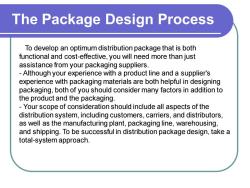
The Package Design Process To develop an optimum distribution package that is both functional and cost-effective, you will need more than just assistance from your packaging suppliers. - Although your experience with a product line and a supplier's experience with packaging materials are both helpful in designing packaging, both of you should consider many factors in addition to the product and the packaging. - Your scope of consideration should include all aspects of the distribution system, including customers, carriers, and distributors, as well as the manufacturing plant, packaging line, warehousing, and shipping. To be successful in distribution package design, take a total-system approach
The Package Design Process To develop an optimum distribution package that is both functional and cost-effective, you will need more than just assistance from your packaging suppliers. - Although your experience with a product line and a supplier's experience with packaging materials are both helpful in designing packaging, both of you should consider many factors in addition to the product and the packaging. - Your scope of consideration should include all aspects of the distribution system, including customers, carriers, and distributors, as well as the manufacturing plant, packaging line, warehousing, and shipping. To be successful in distribution package design, take a total-system approach
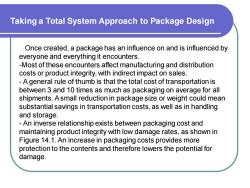
Taking a Total System Approach to Package Design Once created, a package has an influence on and is influenced by everyone and everything it encounters. -Most of these encounters affect manufacturing and distribution costs or product integrity, with indirect impact on sales. - A general rule of thumb is that the total cost of transportation is between 3 and 10 times as much as packaging on average for all shipments. A small reduction in package size or weight could mean substantial savings in transportation costs, as well as in handling and storage. - An inverse relationship exists between packaging cost and maintaining product integrity with low damage rates, as shown in Figure 14.1. An increase in packaging costs provides more protection to the contents and therefore lowers the potential for damage
Taking a Total System Approach to Package Design Once created, a package has an influence on and is influenced by everyone and everything it encounters. -Most of these encounters affect manufacturing and distribution costs or product integrity, with indirect impact on sales. - A general rule of thumb is that the total cost of transportation is between 3 and 10 times as much as packaging on average for all shipments. A small reduction in package size or weight could mean substantial savings in transportation costs, as well as in handling and storage. - An inverse relationship exists between packaging cost and maintaining product integrity with low damage rates, as shown in Figure 14.1. An increase in packaging costs provides more protection to the contents and therefore lowers the potential for damage

Taking a Total System Approach to Package Design Figure 16.1 The optimum packaging system balances costs from excessive damagewith the costs of overpackaging
Taking a Total System Approach to Package Design Figure 16.1 The optimum packaging system balances costs from excessive damagewith the costs of overpackaging

Taking a Total System Approach to Package Design The real cost of getting the product safely to market is the sum of packaging and damage. - Optimizing total cost is the true goal of packaging design. - No matter where in the company your packaging design function is located, in engineering, manufacturing, shipping, or elsewhere, try to include all factors in a total-system approach for an optimum design. The Protective Package Concept Product + Package = Distribution environment Figure 16.2 depicts the consequences of an imbalance in this equation, showing what happens when a product plus its package are not exactly what is needed to survive in the distribution process
Taking a Total System Approach to Package Design The real cost of getting the product safely to market is the sum of packaging and damage. - Optimizing total cost is the true goal of packaging design. - No matter where in the company your packaging design function is located, in engineering, manufacturing, shipping, or elsewhere, try to include all factors in a total-system approach for an optimum design. The Protective Package Concept Product + Package = Distribution environment Figure 16.2 depicts the consequences of an imbalance in this equation, showing what happens when a product plus its package are not exactly what is needed to survive in the distribution process
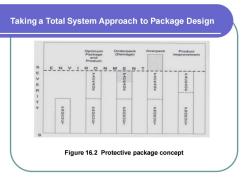
Taking a Total System Approach to Package Design Figure 16.2 Protective package concept
Taking a Total System Approach to Package Design Figure 16.2 Protective package concept
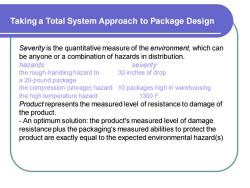
Taking a Total System Approach to Package Design Severity is the quantitative measure of the environment, which can be anyone or a combination of hazards in distribution. hazards severity the rough-handling hazard to 30 inches of drop a 20-pound package the compression (storage) hazard 10 packages high in warehousing the high temperature hazard 1300 F. Product represents the measured level of resistance to damage of the product. - An optimum solution: the product's measured level of damage resistance plus the packaging's measured abilities to protect the product are exactly equal to the expected environmental hazard(s)
Taking a Total System Approach to Package Design Severity is the quantitative measure of the environment, which can be anyone or a combination of hazards in distribution. hazards severity the rough-handling hazard to 30 inches of drop a 20-pound package the compression (storage) hazard 10 packages high in warehousing the high temperature hazard 1300 F. Product represents the measured level of resistance to damage of the product. - An optimum solution: the product's measured level of damage resistance plus the packaging's measured abilities to protect the product are exactly equal to the expected environmental hazard(s)
按次数下载不扣除下载券;
注册用户24小时内重复下载只扣除一次;
顺序:VIP每日次数-->可用次数-->下载券;
- 陕西科技大学:《包装技术基础 Fundamentals of Packaging Technology》课程PPT教学课件(英文版)Lesson 15 Seven Steps for Cushioned Package Development 第15课 缓冲包装设计七步法.ppt
- 陕西科技大学:《包装技术基础 Fundamentals of Packaging Technology》课程PPT教学课件(英文版)Lesson 14 Test Method for Product Fragility 第14课 产品脆值试验方法.ppt
- 陕西科技大学:《包装技术基础 Fundamentals of Packaging Technology》课程PPT教学课件(英文版)Lesson 13 Mechanical Shock Theory 第13课 机械冲击理论.ppt
- 陕西科技大学:《包装技术基础 Fundamentals of Packaging Technology》课程PPT教学课件(英文版)Lesson 12 Shock, Vi ation, and Compression 第12课 冲击、振动和受压.ppt
- 陕西科技大学:《包装技术基础 Fundamentals of Packaging Technology》课程PPT教学课件(英文版)Lesson 11 Package Printing 第11课 包装印刷.ppt
- 陕西科技大学:《包装技术基础 Fundamentals of Packaging Technology》课程PPT教学课件(英文版)Lesson 10 Graphic Design in Packaging 第10课 包装中的平面设计.ppt
- 石河子大学:《工业工程基础》课程PPT教学课件(农机专业,2012)第8章 生产率.ppt
- 石河子大学:《工业工程基础》课程PPT教学课件(农机专业,2012)第4章 工作研究概述.ppt
- 石河子大学:《工业工程基础》课程PPT教学课件(农机专业,2012)现场管理.ppt
- 石河子大学:《工业工程基础》课程PPT教学课件(农机专业,2012)第一章 工业工程概述(1.1)工业工程的发展和作用(主讲人:张慧明).ppt
- 石河子大学:《工业工程基础》课程PPT教学课件(农机专业,2012)第一章 工业工程概述(1.2)工业工程定义和内容.ppt
- 石河子大学:《工业工程基础》课程PPT教学课件(农机专业,2012)预定时间标准及模特法.ppt
- 石河子大学:《工业工程基础》课程PPT教学课件(农机专业,2012)操作分析.ppt
- 石河子大学:《工业工程基础》课程PPT教学课件(农机专业,2012)程序分析.ppt
- 石河子大学:《工业工程基础》课程PPT教学课件(机制专业,2011)第四章 工作研究概述.ppt
- 石河子大学:《工业工程基础》课程PPT教学课件(机制专业,2011)第六章 时间研究与工作抽样.ppt
- 石河子大学:《工业工程基础》课程PPT教学课件(机制专业,2011)第五章 方法研究的分析技术.ppt
- 石河子大学:《工业工程基础》课程PPT教学课件(机制专业,2011)第二章 工业工程概述2/2.ppt
- 石河子大学:《工业工程基础》课程PPT教学课件(机制专业,2011)第一章 工业工程概述1/2.ppt
- 石河子大学:《工业工程基础》课程PPT教学课件(工业专业)第4章 现场管理方法.ppt
- 陕西科技大学:《包装技术基础 Fundamentals of Packaging Technology》课程PPT教学课件(英文版)Lesson 17 Computer Aided Packaging System 第17课 计算辅助包装设计系统.ppt
- 陕西科技大学:《包装技术基础 Fundamentals of Packaging Technology》课程PPT教学课件(英文版)Lesson 18 General Overview 第18课 概述.ppt
- 陕西科技大学:《包装技术基础 Fundamentals of Packaging Technology》课程PPT教学课件(英文版)Lesson 19 The Packaging Line 第19课 包装线.ppt
- 陕西科技大学:《包装技术基础 Fundamentals of Packaging Technology》课程PPT教学课件(英文版)Lesson 1 A History of Packaging 第1课 包装发展史.ppt
- 陕西科技大学:《包装技术基础 Fundamentals of Packaging Technology》课程PPT教学课件(英文版)Lesson 20 Filling Systems 第20课 充填灌装系统.ppt
- 陕西科技大学:《包装技术基础 Fundamentals of Packaging Technology》课程PPT教学课件(英文版)Lesson 2 Packaging Functions 第2课 包装的功能.ppt
- 陕西科技大学:《包装技术基础 Fundamentals of Packaging Technology》课程PPT教学课件(英文版)Lesson 3 Paper and Paperboard 第3课 纸与纸板.ppt
- 陕西科技大学:《包装技术基础 Fundamentals of Packaging Technology》课程PPT教学课件(英文版)Lesson 4 Corrugated Fiberboard Boxes 第4课 瓦楞纸板箱.ppt
- 陕西科技大学:《包装技术基础 Fundamentals of Packaging Technology》课程PPT教学课件(英文版)Lesson 5 Metal Containers 第5课 金属容器.ppt
- 陕西科技大学:《包装技术基础 Fundamentals of Packaging Technology》课程PPT教学课件(英文版)Lesson 6 Glass Containers 第6课 玻璃容器.ppt
- 陕西科技大学:《包装技术基础 Fundamentals of Packaging Technology》课程PPT教学课件(英文版)Lesson 7 Plastics in Packaging 第7课 塑料在包装中的应用.ppt
- 陕西科技大学:《包装技术基础 Fundamentals of Packaging Technology》课程PPT教学课件(英文版)Lesson 8 Flexible Packaging Laminates 第8课 软包装复合材料.ppt
- 陕西科技大学:《包装技术基础 Fundamentals of Packaging Technology》课程PPT教学课件(英文版)Lesson 9 Color 第9课 颜色.ppt
- 沈阳师范大学:《通风除尘与物料输送》课程教学课件(PPT讲稿)流体力学基础 1.1 第一节 空气在管道中流动的基本规律.ppt
- 沈阳师范大学:《通风除尘与物料输送》课程教学课件(PPT讲稿)流体力学基础 1.2 第二节 流动阻力和能量损失.ppt
- 沈阳师范大学:《通风除尘与物料输送》课程教学课件(PPT讲稿)流体力学基础 1.3 第三节 管路中的压力、速度和流量的测量.ppt
- 沈阳师范大学:《通风除尘与物料输送》课程教学课件(PPT讲稿)风机 2.1 第一节 离心式通风机的构造和工作原理.ppt
- 沈阳师范大学:《通风除尘与物料输送》课程教学课件(PPT讲稿)风机 2.2 第二节 离心式通风机的性能参数.ppt
- 沈阳师范大学:《通风除尘与物料输送》课程教学课件(PPT讲稿)风机 2.3 第三节 离心式通风机的选择.ppt
- 沈阳师范大学:《通风除尘与物料输送》课程教学课件(PPT讲稿)风机 2.4 第四节 离心式通风机的安装与使用.ppt
